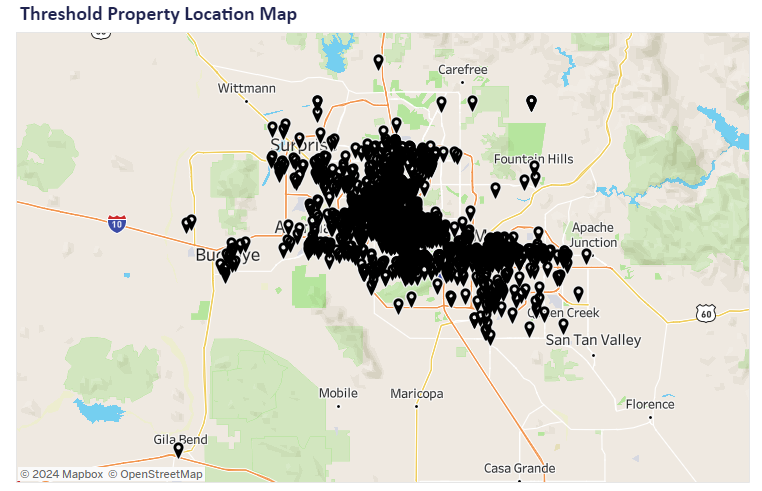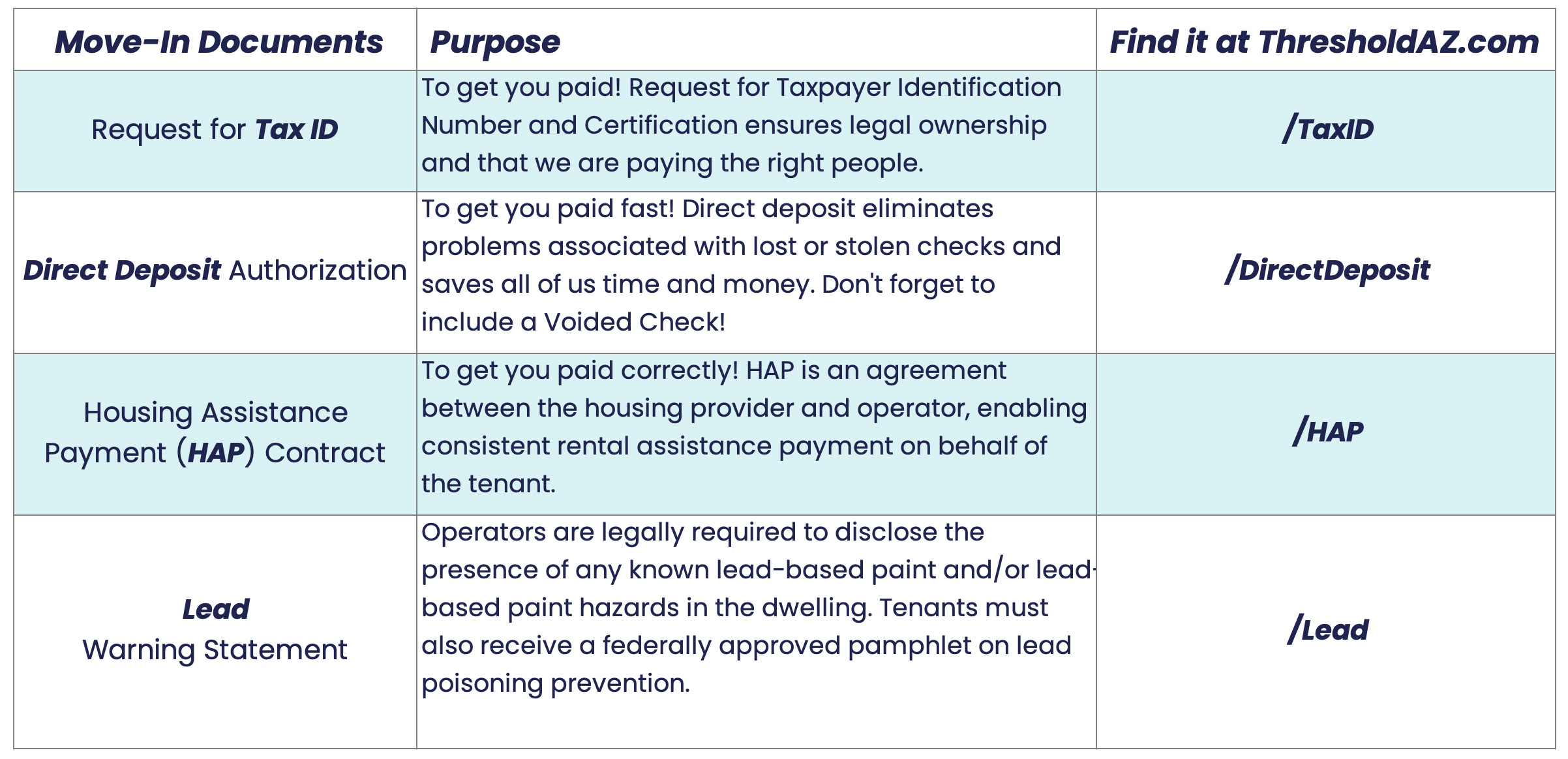The recent rental market downturn has left Arizona property owners and operators facing challenges with keeping properties rented and maintaining stable rates. The rapid rise of rent in recent years has now given way to a more stabilized and softened market, leading to a decrease in both rents and occupancy rates. The shift has resulted in uncertainty among owners and operators who must adapt to the new economic landscape to sustain a steady revenue stream.
As a result of this market fluctuation, Threshold has become a helpful resource for property owners and operators. We believe that communities thrive when everyone has a place to call home. Following the Housing First model, we help individuals and families secure housing quickly, but also work closely with property owners and operators to keep properties rented.
Below, we explore how Threshold helps keep properties viable during a market downturn. We will explain how our resources and support aids owners and operators during this arduous time by ensuring both financial stability and the overall welfare of our beloved Arizona communities.

The recent market downturn has forced property owners and operators to reevaluate their strategy to keep units occupied.
Understanding Recent Market Trends
From 2020-2022, Maricopa County saw a major shift in the housing market as rental rates climbed 46% – one of the highest rent increases in the United States during that period. The quick rise in rent presented new hurdles for potential renters, especially those relying on rental assistance programs. During this time, the rental amounts authorized for housing programs by state and federal funders – known as Fair Market Rents (FMRs) – were not sufficient to cover the drastic increase in monthly rent. This meant that renters could not secure housing even if they were receiving FMRs because rents far exceeded the amounts allocated.
In 2022, the United States Department of Housing and Development (HUD) made a concerted effort to ease the strain on housing programs by providing an update to FMRs that more accurately reflected the current market. The result was a 35% increase in funding for Maricopa County – the second highest adjustment in the nation. The move temporarily eased some of the challenges faced by local housing programs, allowing them to present more market-friendly rates for renters.
By the fall of 2023, the market began to stabilize, and rent and occupancy rates started to decline. Year-over-year, both metrics dropped more than 3%, signaling a shift toward a more balanced rental market. This stabilization is a double-edged sword for property owners and operators: while it curbs the unsustainable rent hikes of previous years, it also necessitates a strategic approach to stay competitive during a softer market.
How the Downturn Impacts Owners and Operators
When the rental market faces a downturn, it can affect property owners and operators in a few different ways. Let's take a closer look:
- Reduced Rental Income: As the rental market softens, there is less potential for a year-over-year rent increase. Many owners and operators who are accustomed to raising the price of rent every year now must adjust their pricing to align with the current market.
- Increase Vacancy Rates: Lower occupancy rates also mean higher vacancy rates, resulting in less income for property owners. Vacant units not only mean lost income but can also result in additional costs for maintaining these units until they are rented.
- More Competition: More vacant rentals in the marketplace means property owners and operators need to be creative to stand out from the crowd. This can lead to increased marketing costs, potential property improvements or more flexible leasing terms to attract renters.
Understanding these potential impacts can help property owners and operators effectively navigate a market downturn. However, it requires a shift in focus from the short-term gains of rent increases to more long-term stability through effective property management and increased tenant retention.
This is where Threshold plays a key role. We provide the necessary resources and support to help property owners and operators keep occupancy and rates stable despite the changing market.

Since 2021, Threshold has helped 400 property owners and operators fill vacancies at more than 1,000 properties in Maricopa County.
How Threshold Helps Property Owners and Operators
Historically, property owners and operators have been hesitant to engage with the most vulnerable populations due to the stigma associated with homelessness and the perceived risks involved. Many housing systems focus on tenant needs without adequately addressing the concerns of property owners and operators, leaving a significant gap in collaborative efforts to resolve the housing crisis.
Threshold bridges this gap by meeting the needs of property owners and operators, ensuring they can run successful and well-maintained properties while providing safe and stable homes for those in need. By engaging these key stakeholders, we foster a cooperative approach that benefits the entire housing sector, making it easier for service providers to work with property owners and operators to facilitate housing for tenants.
Our innovative approach has led to some significant achievements. In our first two years, we enabled our partners to find market-leased homes for 3,065 individuals and families who were previously unhoused. This includes mitigating the risk screening criteria accounts for, including:
- 126 households with criminal convictions
- 117 households with previous evictions
- 127 households that were housed without income requirements.
These accomplishments demonstrate our ability to overcome barriers that typically prevent the most vulnerable individuals from finding housing. Additionally, on average, tenants spent 29 fewer days searching for housing, thanks to our streamlined processes and robust support system.
Partnering with Threshold has translated into tangible benefits. Since 2021, over 400 property owners and operators overseeing 1,024 properties have filled vacancies by partnering with us. By providing a consistent tenant base and reducing the time units remain vacant, we help property owners and operators stay financially stable.
Why Partner with Threshold During a Downturn?
One of the primary benefits for property owners and operators who partner with Threshold is a significant reduction in vacancies. During a market downturn, vacant units represent a direct loss of income. We mitigate this risk by ensuring a steady stream of tenants who are ready and eligible to move in. Through the Housing First model, we prioritize placing tenants quickly, which decreases the time properties sit vacant. This approach is especially beneficial during a market downturn, when finding tenants can be more challenging.
Stabilizing rents and occupancy levels directly contributes to financial stability and long-term success for property owners and operators. In a softening market, the temptation might be to increase rents to offset potential losses. However, such a strategy can backfire by driving away tenants and increasing vacancies. We help property owners and operators strike a balance by maintaining fair and reasonable rents that reflect current market conditions.

We mitigate risk by ensuring a steady stream of tenants who are ready and eligible to move in. Through the Housing First model, we prioritize placing tenants quickly, which decreases the time properties sit vacant.
Common Concerns of Property Owners and Operators
Here are a few concerns we commonly hear from our property owners and operators during a market downturn:
Concern #1: Rent should increase every year because the cost of living continues to rise.
Response: The recent adjustments in Fair Market Rents (FMRs) mean that rents are now more aligned with actual market conditions. This correction ensures that rents remain fair and sustainable, preventing the risk of pricing out tenants and increasing vacancies. Stable rents help maintain tenant retention, which is a more effective management plan than focusing on the short-term gains of annual rent increases.
Concern #2: If I lower my rent, I will lose income.
Response: Competitive rents, along with high occupancy rates, is the key to success. Avoiding frequent tenant turnover ensures property owners and operators maintain a consistent rental income. This approach reduces the risks associated with vacancies and the costs of re-leasing units, ultimately protecting and enhancing your investment.
Next Steps for Property Owners and Operators
To stay ahead in the competitive Arizona market, property owners and operators need to be proactive. Following these easy steps can provide a pathway to stability and success:
- Work with Threshold to understand the support and resources available for property owners and operators.
- Use platforms like Padmission to streamline the leasing process and attract qualified tenants quickly.
- Regularly update property listings to reflect current market conditions and available amenities.
- Benefit from our extensive network and expertise by participating in programs that ensure fair rents and high occupancy.
- (*Optional) Invest in property maintenance and upgrades to make your rentals more attractive to potential tenants.
By implementing these practical steps, property owners and operators can not only navigate, but thrive during a market downturn. Have questions or want to discuss Threshold in more detail? Contact us today!














